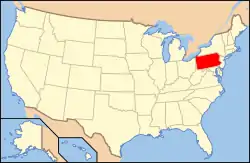The Woodlands (Philadelphia)
The Woodlands is a National Historic Landmark District on the west bank of the Schuylkill River in Philadelphia. It includes a Federal-style mansion, a matching carriage house and stable, and a garden landscape that in 1840 was transformed into a Victorian rural cemetery with an arboretum of over 1,000 trees. More than 30,000 people are buried at the cemetery.[3]
The Woodlands | |
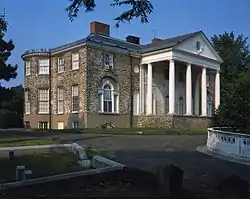 Woodlands Mansion | |
| Location | 4000 Woodland Avenue, Philadelphia, Pennsylvania, US |
|---|---|
| Coordinates | 39°56′49″N 75°12′11″W |
| Area | 53 acres (21 ha) |
| Built | 1770; rebuilt 1786–92 |
| Architect | William Hamilton |
| Architectural style | Neoclassical; Robert Adam Style |
| NRHP reference No. | 67000022[1] |
| Significant dates | |
| Added to NRHP | December 24, 1967 |
| Designated NHLD | December 24, 1967 |
| Designated PHMC | December 28, 1996[2] |
Hamilton estate (1735–1840)
The land that would become The Woodlands was originally a 250-acre (1.0 km2) tract in Blockley Township on the west bank of the Schuylkill River. It was purchased in 1735 by the famous Philadelphia lawyer Andrew Hamilton.
When Hamilton died in 1741, he willed his lands to his son, also named Andrew. The son survived his father by only six years, but in that time built up his landholdings enough to leave a 300-acre (1.2 km2) estate to his own son, William Hamilton (1745–1813), who acquired it at the age of twenty-one. William built a Georgian-style mansion with a grand, two-storied portico overlooking the river above Gray's Ferry. Following a trip to England after the American Revolution, Hamilton doubled the size of the dwelling, creating a 16-room manor with kitchens and service rooms in a windowed ground floor. The rebuilt Woodlands mansion became one of the greatest domestic American architectural achievements of the 18th century, recognized as a leading example of English taste and presaging architectural trends in the following century.
Hamilton was an active botanist, and his estate and greenhouses grew to contain more than 10,000 species of plants, including the first specimens introduced into America of the Ginkgo biloba, Paper Mulberry, Sycamore Maple, Ailanthus, Caucasian Zelkova, and Lombardy Poplar as well as plants grown from seeds harvested during Lewis and Clark’s expeditions, especially the Osage Orange (Maclura pomifera). Hamilton also collected and exchanged numerous native plants with his friends and neighbors, the Bartram family of botanists from nearby Bartram's Garden.
At one time, the estate covered 600 acres (2.4 km2) and stretched from the Schuylkill River to what is now Market Street on the north and 42nd Street on the west and incorporated Hamilton Village.
Cemetery (1840–1960)
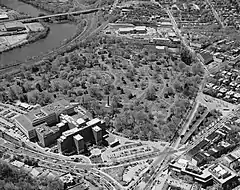
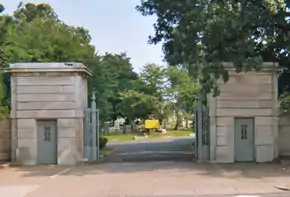
After Hamilton died in 1813, his heirs sold off much of the Woodlands estate for institutional and residential development. By the first quarter of the 19th century, the West Philadelphia district was becoming a fashionable suburb. In order to save the core of Hamilton's estate, in 1840,[4] The Woodlands Cemetery Company of Philadelphia purchased the last 92 acres (37 ha), which included the mansion, carriage house, greenhouse and hot houses, as well as extensive plantings. The founders concluded that The Woodlands' isolated location, its array of exotic trees and its commanding view of the Schuylkill River provided an ideal site for a rural cemetery. John McArthur, Jr. designed the entrance architecture, which was demolished in 1936.[4]
As with its rival to the north, Laurel Hill Cemetery, trustees of the Woodlands spurred the cemetery's early growth by interring the remains of a celebrity: Commodore David Porter. His remains, originally buried at the Philadelphia Naval Asylum cemetery, were reburied at Woodlands in 1845. By mid-century, The Woodlands was thriving and attracted many of Philadelphia's renowned industrialists, medical professionals, artists, writers, and veterans.[5]
In 1853, the land along the river was sold to the West Chester and Philadelphia Railroad, which built a rail line along it. Over the next century, other railroads, particularly the Pennsylvania Railroad, added tracks. (Today, eight tracks run along former Woodlands land, serving Amtrak passenger trains, Conrail freight, and the SEPTA Airport and Media commuter lines.)[6]
Modern use (1960-)
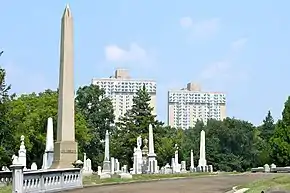
The Woodlands estate was designated a National Historic Landmark in 1967. In 2006, the cemetery and other structures on the site were added to form a National Historic Landmark District.[7]
Today, The Woodlands Cemetery Company of Philadelphia exists as a non-profit cemetery corporation that promotes both traditional and current burial practices on its 54 acres (22 ha) of land in University City. The company is supported by The Woodlands Trust for Historic Preservation, a non-profit corporation, dedicated to the preservation and promotion of the cemetery, mansion, and arboretum as a cultural landscape between the University of Pennsylvania and the University of the Sciences in Philadelphia.
The pathways and avenues of the cemetery and mansion make up the Woodlands Heritage National Recreation Trail, part of the National Recreation Trail program. The cemetery includes a looped road system emanating from a central paved circle [8] with infrequent motor vehicle traffic, making the grounds a safe and quiet place for biking, running and walking. There is also an unpaved path that encircles the perimeter of the grounds that is a popular circuit for University City dog-walkers and runners. Leashed dogs are permitted on the grounds, which are free and open to the public from dawn to dusk. The cemetery also hosts a community garden, community activities, an orchard, and apiary.
Notable burials
|
|
|
See also
References
- National Park Service (June 2010). "National Historic Landmarks Program: List of National Historic Landmarks by State" (PDF). Retrieved 2010-07-16..
- "PHMC Historical Markers". Historical Marker Database. Pennsylvania Historical & Museum Commission. Retrieved December 10, 2013.
- "The Woodlands Cemetery Company". The Woodlands Cemetery Company. Retrieved December 11, 2013.
- "Woodlands Cemetery. Main Entrance". The Library Company of Philadelphia. World Digital Library. Retrieved 4 January 2014.
- Keels, Thomas H., Philadelphia Graveyards and Cemeteries (Portsmouth, NH: Arcadia Press, 2003)
- Rosenthal, James W. (2003). "VIEW OF THE RAILROAD TRACKS AND SCHUYLKILL RIVER". Print and Photographs Online Catalog. Library of Congress. Retrieved November 26, 2012.
- James A. Jacobs, Aaron V. Wunsch, and Catherine C. Lavoie, National Historic Landmark Nomination, The Woodlands, Additional Documentation, March 20, 2006.
- see map Archived 2012-04-25 at the Wayback Machine
- "Cemetery map". University City Historical Society. Archived from the original on 2009-02-28. Retrieved 2009-03-24.
External links
| Wikimedia Commons has media related to The Woodlands Cemetery. |
- Official website
- Woodlands Cemetery at Find a Grave
- Historic American Buildings Survey (HABS) No. PA-1125, "The Woodlands"
- HABS No. PA-1125-A, "The Woodlands, Stable-Carriage House"
- Historic American Landscapes Survey (HALS) No. PA-5, "Woodlands Cemetery"
- The mansion's listing and images at Philadelphia Architects and Buildings
- The cemetery's listing and images at Philadelphia Architects and Buildings
- The cemetery gate and drive's listing and images at Philadelphia Architects and Buildings
- Three 1924 photos from Gray's Ferry Bridge north to the outlet of Mill Creek and The Woodlands: Photo 1, Photo 2, Photo 3
- The Woodlands Cemetery Company papers, documenting the growth and activities of the cemetery since its founding, are available for research use at the Historical Society of Pennsylvania.

